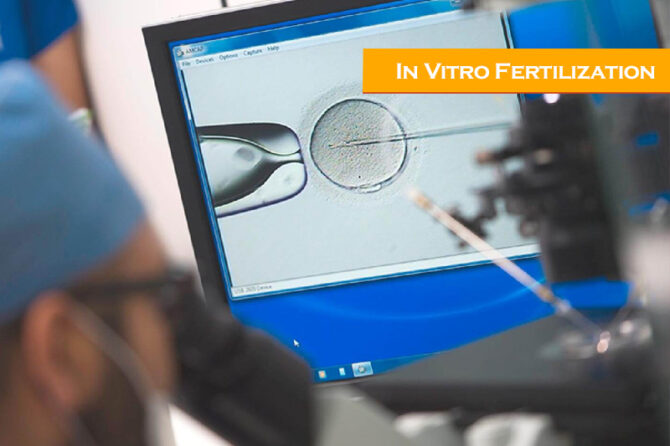In Vitro Fertilization
A couple who have had a regular sex life for 12 months without having children have been diagnosed with infertility, the problem of infertility has been out of date, and modern medicine cope with this problem with different methods. Supporting reproductive technologies
Vitro fertilization, which is widely used today in the vagina of men and women, is widely used. In vitro fertilization means mixing sperm and ozone in a woman’s body (is natural way), but in artificially created environment – laboratory.
Artificial fertilization has been made available thanks to the high tech achievements of clinical embryology and medicine. One of the important phases is the embryological procedures embryologists in a special laboratory. Their task is to adopt as many high quality embryos as the manipulation of various manipulations – IVF, ICSI, IMSI, PGD, embryos and oocytes.
If doctor reproductologist want to appoint in vitro fertilization, it is necessary to conduct the following studies:
-Conduct research on hormonal and infections;
-Maternal and thyroid glands are the ultrasound;
-Gynecological ultrasound;
-Abdominal cavity is a complete ultrasound and determines the anti-molecular hormone;
-Diagnostic laparoscopy is a hysteroscopy.
-Spermogram
In vitro procedure consists of several stages:
1. Ovarian stimulation
Successful implementation of in vitro procedure is to get matured eggs, which is achieved by medication stimulation of the female organism. Depending on the patient’s individual data, a doctor reproductologist establishes a dose of treatment and dose of preparations. The purpose of hormonal stimulation is to get mature and high quality eggs, and on the other hand prepare uterine endometrium for embryo. The stimulation process is controlled by ultrasound.
2. Follicular puncture
When the follicles become ripe or the desired size, the next stage of the ventral procedure begins – the aspiration of the follicles content and the ovulation. This procedure is carried out by means of transvaginal puncture, ultrasound control. The fluid received is embedded into an embryo laboratory where the embryologist sees the eggs, cleanses, in a special fluid and evaluates the quality of their maturity. Eggs are kept in the incubator for several hours.
In this period the sperm is processed. With the help of modern special solutions, it is possible to separate morphologically complete and movable spermozides from the seed fluid and clean bacteria and dead spermozides.
3.Artificial insemination
At the time of artificial insemination, the doctor embraces the embryo by joining sperm and ozone. Fertilization of egg fertilization is the successful ending of the first stage of the procedure.
In accordance with sperm quality, it is conducted or in vitro fertilization (IVF) or intracytoplasmic sperm injection (ICSI).
In vitro fertilization (IVF) sperm indicators – concentration should be within the framework of the norm. The eggs are processed and processed in the incubator for 17-20 hours. During this time, spermicides have similar effect on the natural processes of the egg cells and have been able to achieve them.
If the sperm quality is low, eggs are intrusive-plasma sperm injection (ICSI). At this time only one sperm is needed to make one egg. The embryo inhibits the integrity of the membrane membrane with the help of a special microinactor and spermatozoid into it mechanically. Men’s infertility (oligospermia, asthenosphere, oligasthenospermia) does not actually affect the outcome of ICSI. The main thing is to get a certain amount of live sperm counters.
Within 17-20 hours after the addition of sperm in the eggs, the embryo evaluates fertilized eggs – the amount of zygote and quantity. At this stage, a normal fertilized egg is a single cell that has two protein (nuclei) of mother and father’s genetic information. The oocytes are divided and the second polar bodybuilding with chromosomes of the halldide is formed (the first polar bodybuilding of the egg is formed during the ripening period). All the signs of fertilization have already been revealed. Zigoda is divided after 30 hours after fertilization. The cells are generated by geometric progress – two, four, eight, etc.
It is established that the synthesis of substances needed for the growth and development of future embryos in the unexplored egg is still established, and in the incubator it is placed in adequate temperature and osmotic conditions.
After 48 hours after fertilization the embryo still evaluates the quality of embryos, observes the external shape, division frequency, number of cells, size, shape, fragmentation quality, frequency, embryonic membrane thickness, vitality. According to this data embryos are found in different groups.
It should be noted that the embryo size does not grow at the time of division, on the contrary, is also reduced to some degree. When the number of cells reaches a certain number, the intensity of the division is reduced. The four-day embryo is called morula. Cells are compact in it. The outer layer of the mole is intensively supplying cells with ions and water. Because of this, the intracellular space increases after a period of time and the embryo passes into the blastosis stage.
Embryo is already ready for implantation. Blastocyst consists of a thin membrane of the cells and the inner cell mass, from which the germous tissues develop.
Development of embryo in vitro, according to the rules, is 3-5 days. Then we go through a special catheter in the uterine cavity. After that, pregnancy continues in the same way as the natural process.
In vitro fertilization does not mean that 100% of pregnancy results in in vitro fertilization in any country of the world in any case with no positive results. The birth rate and subsequent child index is different in different age groups. The highest rate is 25-37 years of pregnancy in women, which is 45-50 percent. The aging process of aging starts aged 38-40, which has a significant negative impact on pregnancy and causes a reduction in the percentage of pregnancy decrease in age between 42 and 44 years, up to 15-20% and 45 years. This figure is 5-8%.
Leave a reply



Leave a reply